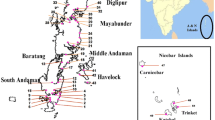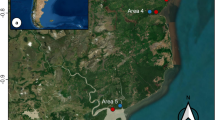Abstract
Coringa mangrove forest is located in the Godavari delta, Andhra Pradesh, India. The mangrove community consisted of more than 13 species of mangrove and other plants in the present study area. The following three dominant mangrove plants,Avicennia marina, Excoecaria agallocha andSonneratia apetala were found to be present on the banks of a major channel of the Godavari river running through the forest. The structure and species distribution of mangrove, in the Channel Nagathana Kalaya has been described. The area behind the belt consisting ofAcanthus ilicifolius andMyriostachya wightiana is generally colonized byE. agallocha andA. marina. The zone has been called theAvicennia andExcoecaria zone. Adjacent to this zone species likeAegiceras corniculatum andA. officinalis were the common species. In the flat clayey soil,Suaeda maritima was found to grow. In areas of high elevation, devoid of inundation of tidal seawater during the high tidal period, species such asM. wightiana andAcanthus were found to colonize both the banks of the channels.
An analysis of species diversity, indicated a definite trend in the distribution of mangrove from the mouth of the estuarine region to the inland waters.
The levels of atmospheric pollutants such as sulphur dioxide (SO2), oxides of nitrogen (NOx), ammonia (NH3) and suspended particle matter (SPM) were within the legal limits.
Similar content being viewed by others
References
Azariah, J., H. Azariah, P. Pandion & S. Gunasekaran, 1990. Coastal wetlands of Kakinada, Andhra Pradesh. A case study in environmental impact assessment. In Wetland ecology and management, Bharatpur (in press).
Azariah, J., P. Banth, H. Azariah & V. Selvam, 1986. Impact of urbanization on the status of mangrove swamps of Madras. In D. D. Hooketal., (eds), The Ecology and Management of Wetlands, Croom Helm, London: 225–233.
Blasco, F., 1975. Mangroves of India. Inst. Fr. Pondicherry. Tran. Sect. Sci. Tech., 15, 175 pp.
Indian Express, 1990. Kakinada Port-Gateway for trade and industry. March, 2: 1–15.
Rao, T. A., K. R. Agerwal & A. K. Mukherje, 1963. An ecological account of the vegetation of Rameswaram Island. Bull. Bot. Surv. India, 5: 301–323.
Saenger, P., E. J. Hegal & J. D. S. Davie, 1983. Global status of Mangrove ecosystems. Commission on Ecology, Paper No. 3, IUCN Gland. 88 pp.
Sarma, D. V. R. & P. N. Ganapti, 1971. Hydrography of the Coringa river of the Gautami-Godavari estuarina system. J. mar. biol. Ass. India. 13: 234–248.
Sidhu, S. S., 1963. Studies on the mangrove of India. I. East Godavari region. Indian Forestar. 89: 337–351.
Venkatesan, K. R., 1966. The mangroves of Madras state. Indian Forestar, 92: 27–34.
Author information
Authors and Affiliations
Rights and permissions
About this article
Cite this article
Azariah, J., Azariah, H., Gunasekaran, S. et al. Structure and species distribution in Coringa mangrove forest, Godavari Delta, Andhra Pradesh, India. Hydrobiologia 247, 11–16 (1992). https://doi.org/10.1007/BF00008200
Issue Date:
DOI: https://doi.org/10.1007/BF00008200




